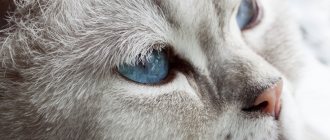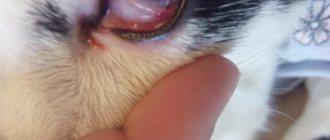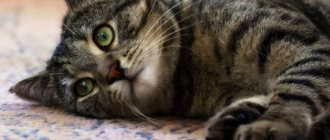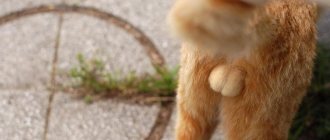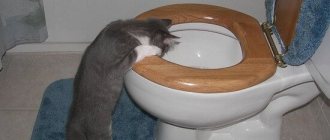How to cure a pet
Owners often ask the question: “The cat is sneezing, what should I do at home?” Your four-legged friend can be treated at home if he does not have a serious illness that threatens his health.
At home
First of all, get rid of drafts in the room. Provide your pet with a cozy, warm place to sleep and relax. It is advisable not to disturb him again during illness. Give plenty of fluids and medications recommended by your doctor. Never self-medicate or offer pills intended for humans without consulting a veterinarian. This is fraught with a lot of problems, since “human” pills are not designed for such a small weight. – an overdose or a severe allergic reaction is possible.
If your cat has an allergy, try to find the allergen and eliminate its presence in the house as much as possible. Sometimes the litter for your pet is not suitable for you - try changing it to another one. If you have started general cleaning, do not spray household chemicals near your pet: lock it in the room, on the balcony, give it to a friend or neighbors for this time, so as not to once again provoke an unwanted process.
When contacting a sick animal, there is a high risk of contracting viral infections or rabies. This is especially true for our little brothers, who are taken to the country in the summer. Therefore, do not neglect vaccinations. Once a quarter, deworming is required, because animals sitting at home can become infected with worm eggs through dirty shoes, clothes, bags, bicycles, and strollers. And the most important advice - at the slightest suspicion of an illness, go to see a veterinarian.
Visit to the veterinary clinic and doctor's appointment
Visits to veterinary hospitals must be made at least once a year. This is done both for prevention and timely detection of dangerous diseases. Depending on the type of illness, the specialist will select effective medications to promote a speedy recovery.
If your pet has a common cold and runny nose, he will be prescribed injections, antibiotics, animal drops and observation by a doctor for a week. If it is an allergy, then antihistamines or special soothing ointments will be prescribed for the affected skin.
In case of exacerbation of viral infections, antibacterial drugs, specific serums, antibiotics, protein-vitamin and mineral complexes are prescribed to maintain immunity. Treatment of fungal diseases begins with tests to identify the type of fungus, after which the veterinarian allows the use of sulfur ointment, iodine, brilliant green, antifungal vaccines, and potassium iodide.
In serious cases of sinus cancer, radiation therapy and chemotherapy are used in combination with medications that stimulate the immune system.
It is impossible to make a diagnosis and prescribe treatment without examining your pet. Any qualified veterinarian will confirm this - and even refuse consultation over the phone, inviting the owner and pet to a “confrontation”.
Why does my pet sneeze?
The sneezing process can be caused by various reasons. If your cat sneezed violently just a few times in a row, then most likely dust particles got into her nose. Frequent sneezing occurs due to:
- allergies;
- foreign body in the respiratory tract;
- diseases of the respiratory system;
- worms;
- problems with teeth.
Allergies in cats
Cats, like people, experience allergic reactions. Animals begin to sneeze and rub their noses with their paws. Often, allergies develop to chemical detergents and cleaning products that owners use when cleaning their homes. Allergens also include plant pollen and cigarette smoke. Some cats start sneezing because of cat litter. Their eyes water.
Finding out the cause of an allergic reaction is quite difficult. If your pet starts sneezing, then look at what objects it comes into contact with, remember what chemicals you used when you had to do the cleaning. For example, you washed the cat's food bowl using some kind of detergent, or sprayed air freshener in the presence of the animal.
Presence of a foreign body
When eating food in a hurry, pieces of food, water, and during play - small objects (buttons, small parts from toys, pins) get into the respiratory tract. Fluids leave the respiratory system due to a reflex contraction of the muscles of the larynx.
With solid objects the situation is different. They linger inside, constantly causing a sneezing reflex and coughing. If a foreign body enters your cat's respiratory tract, contact your veterinarian immediately for help. In such cases, you cannot hesitate, because it is difficult for the animal to breathe. It may die.
Respiratory system diseases
Sneezing is a sign that the cat has a cold or has some kind of respiratory illness. For example, a cat fell ill with rhinitis. With this disease, the nasal mucosa becomes inflamed due to parasites or mechanical damage. In addition to sneezing, the following symptoms are observed:
- eyes water;
- a runny nose appears (snot of a serous, mucous, mucopurulent nature);
- crusts appear around the animal’s nostrils;
- wheezing is heard when breathing;
- inhalations and exhalations are made through the mouth;
- the animal does not eat well;
- The pet has a hot nose.
Treatment of rhinitis consists of eliminating the cause of the disease. Veterinarians recommend cleaning the nasal passages of cats, rinsing them with astringent solutions, and inhaling sulfonamides and antibiotics.
The reason why a cat sneezes several times in a row may be due to bronchial asthma. When the disease occurs, attacks of suffocation are observed. A sick animal, as a rule, sits with its neck stretched out, sniffles, wheezes, coughs, and tries to breathe through its mouth. If your pet has difficulty breathing, you should immediately take it to a veterinary clinic. After diagnosis, the doctor will advise treating the disease at home with drugs that dilate the bronchi.
Helminths
Do cats sneeze from worms? This is a pressing question for pet owners. Helminths sometimes cause sneezing. Some types of parasites, when they enter the intestines, do not remain there, but penetrate through the mucous membrane into the blood vessels, then enter the lungs through the bloodstream. Being in the bronchi, helminths cause irritation. When sneezing and coughing, they enter the oral cavity and are swallowed again by the animal.
Heartworms are very dangerous. Veterinarians, identifying them, immediately prescribe treatment. Worms enter the body after a mosquito bite. Helminth larvae travel through the bloodstream to the heart, where they remain. The growth and development of worms occurs in the organ.
Adults cause blockage of arteries. The pet begins to breathe heavily, sneeze and cough. As a result, infection with heartworms leads to a sad outcome - the cat has a heart attack and dies. That is why it is necessary to treat helminthic infestations.
Dental problems
Another reason for sneezing is bad teeth. Infectious and inflammatory processes occurring in the oral cavity often spread to the nasal area. In this regard, the domestic cat begins to sneeze and rub its nose with its paw for no apparent reason, and snot appears. Due to her illness, she doesn't eat well.
To save your pet from dental problems, take him to the veterinarian. Appropriate treatment (such as tooth or tartar removal) may be required. To prevent oral diseases in your pet, use a special toothpaste for animals or purchase food, some of which have now begun to help partially remove plaque.
What measures should be taken?
Nosebleeds in a cat are a serious symptom that requires immediate attention. What to do if a cat has a nosebleed and what does this indicate?
Causes of the disease
A cat's nose consists of two parts: bone and soft (shell). The mucous membrane, containing nerve endings and blood vessels, lines the nasal cavity. In case of inflammation of the nasal mucosa or mechanical damage to its vessels, profuse bleeding from the nose occurs. Sometimes a cat sneezes blood.
However, a pet's nosebleed may be the main consequence of:
- injuries (fall, impact);
- chronic hypertension (constant high blood pressure);
- entry of a foreign object into the upper respiratory tract;
- infectious disease;
- use of medications (for example, Warfarin);
- oncological pathologies;
- poisoning;
- hemophilia (chronic bleeding that develops against the background of decreased blood clotting);
- fungal infections;
- purulent inflammation;
- dental problems.
First aid
- It is necessary to calm the animal. Otherwise, an excited state can increase blood pressure, which will contribute to increased bleeding. Never give your pet sedatives. This can only harm the situation.
- Calm down yourself.
Remember: the cat detects the nervous state of its owner.
- You can reduce bleeding by applying an ice pack to the bridge of your nose.
- If there is no positive dynamics and if there is difficulty breathing, urgently call a veterinarian at home or go to the clinic yourself.
If you notice swelling on the body, deformation or asymmetry of the muzzle, the appearance of the third eyelid, its redness, swelling of the back of the nose - this should be reported first.
Important: these pets are accepted without a queue! Black, soiled stool indicates intestinal bleeding. Vomiting blood - about stomach
However, vomiting after bleeding may be a consequence rather than a cause, since the cat simply swallows a large amount of blood. If the mucous membranes of the oral cavity become marbled in color, immediately tell your doctor. This is a clear sign of severe bleeding; the pet needs urgent hospitalization and qualified care. The veterinarian should be notified of any medications the cat may have taken.
Diagnostics
If your cat has persistent nosebleeds, you should immediately consult a doctor. Otherwise, irreversible processes may begin in the animal’s body. The veterinarian prescribes the following examinations:
- General analysis of blood and urine (assessing the extent of blood loss by counting platelets, identifying the source of inflammation, identifying problems in the kidneys).
- Biochemical blood test (determining the rate of clotting, assessing the functioning of internal organs).
- Serological test (detection of diseases caused by fungal infection).
- Rhinoscopy (detection of a foreign body, its removal).
- X-ray of the chest, nose (excluding pulmonary hemorrhage, assessing the condition of the nasal sinuses, tooth roots).
- Pressure measurement.
- Surgical method (used in exceptional cases when other tests have not helped to identify the cause of nosebleeds, necessary to remove a foreign body in hard-to-reach places or take a tissue biopsy).
Once the diagnosis is made, the veterinarian prescribes treatment, the purpose of which is to eliminate the original cause of the bleeding. As a rule, it is medicinal. If cancer is detected, a surgical method (tumor removal) can be used.
Why do cats cough? What could this symptom indicate? — read the article What to do if your cat coughs?
Types of bleeding
There are two types of bleeding - unilateral and bilateral. This is an important point to pay attention to when diagnosing the disease.
Unilateral
In case of unilateral bleeding (from one nostril), the animal must be examined by a veterinarian. The most common causes of this are foreign bodies in the nose, trauma and tumors.
Bilateral
Bilateral bleeding (from both nostrils) may indicate an infectious disease.
What to do if your cat has a nosebleed
Heartworm infection in a cat
It is extremely rare, but still occurs in practice, that such cute creatures as cats become infected with heartworms when they find themselves in places with very high air humidity and a maximum number of mosquitoes. Why these insects? Yes, because it is through their bite that the parasite is transmitted to the pet. The heartworms themselves, once in the cat’s body, affect the right side of the heart, as well as the lungs. As a result, the arteries become clogged, it becomes difficult to breathe, and coughing and sneezing begins. And the end is often sad - a heart attack and death.
To protect your mustachioed pet from these parasites, follow the following preventive measures:
- maintain strong immunity,
- ensure proper diet and lifestyle.
And when traveling outdoors, you can prepare a special mosquito repellent in advance (dilute citronella with plain water). This composition will reduce the risk of parasite infection to a minimum, which will undoubtedly preserve the health and, of course, the life of your pet. This is just the simplest measure to prevent infection with malicious worms. Your veterinarian will cover this topic in more detail.
What to do if your cat sneezes
There are many reasons for frequent sneezing. Some of which are harmless. A simple reminder will help owners understand them:
- Single sneeze – no need to do anything.
- The cat sneezed several times, then stopped - it is worth observing the condition for the next 2-3 hours. If the sneezing does not recur, nothing needs to be done.
- A cat always sneezes in the same circumstances (during feeding, on the bed, after the owner has used an aerosol or smoked) - eliminate the provoking factor.
- The pet has a stuffy nose, his breathing is hoarse, similar to snoring - provide his favorite food, drink plenty of fluids, avoid drafts, hypothermia.
- Signs of a cold persist for more than 2 days without noticeable relief - consult a veterinarian.
- Purulent discharge from the nose has appeared - ensure the highest possible hygiene of the coat.
- Bloody discharge - apply a cold compress.
- Transparent, but plentiful - provide care for the coat.
- Any discharge that persists for more than a day without noticeable improvement - contact your veterinarian.
- The appearance of purulent discharge from the eyes, especially if the kitten’s eyes are purulent, contact a veterinarian.
- Bad breath, refusal to eat, vomiting, diarrhea - contact your veterinarian.
- The cat periodically breathes hoarsely, opens its mouth, attacks occur under the same conditions - contact a veterinarian.
Treatment
First aid consists of giving the cat a sedative and applying a cold compress to the nose. You shouldn’t panic, because the felinologist’s condition is transmitted to the cat, he rushes about, and the bleeding intensifies.
Treatment consists of stopping hemorrhage using cold and vasoconstrictor medications. If symptoms of an infectious disease are detected, antimicrobial agents are prescribed. In severe situations, surgery is performed.
A cat sneezes: the reasons for this phenomenon
An animal may sneeze for natural reasons, for example, a speck of dust has entered its nasal passages.
But there are also reasons why owners should really think about it. Let's list them.
A cat may sneeze due to:
- polyps inside the nose;
- colds;
- presence of allergies;
- cancer of the nasal cavity;
- problems with gums or teeth;
- sinus infections.
Why does a cat sneeze? If this happens all the time, then this indicates the presence of an infection that is located in the upper respiratory tract. This may be a herpes virus, parainfluenza virus or adenovirus.
The first named infection takes a very long time to be treated, complicated by exacerbations.
In addition, the cat, like any creature, is susceptible to allergic irritants.
These include substances such as:
- tobacco smoke;
- pollen;
- insect sprays;
- perfume;
- mold;
- cleaning (household) products.
Upon contact with an allergen, the purr immediately begins to sneeze
Particular attention should be paid to cats with a flat nose, for example, Persian. Breeds with short nasal passages are primarily susceptible to irritants
What should I do at home if my pet sneezes?
All pets that are experiencing sneezing and snorting with increasing frequency should visit a veterinarian. Here are a couple of simple, common sense tips for pet owners whose animals sneeze or snort constantly.
- Limit your pet's movement.
Place your pet in a crate or small area (such as a bedroom or bathroom) to observe his behavior. - Don't overload your pet.
Long walks or exercise should be avoided until you can take your pet to the vet. - Take your pet's temperature.
If your pet has a high fever (over 40-41 degrees), contact your veterinarian as soon as possible.
If your pet is suffering from other obvious symptoms, such as difficulty breathing, pain, poor appetite, or is simply acting differently than usual, take him to the vet immediately - if necessary, to a hospital with a intensive care unit. Additionally, if there is nasal discharge or the sneezing is productive, meaning mucus, blood, or other discharge is produced, your pet should see a doctor. These are usually signs of a more urgent health condition than the advice given here.
If you don't know what to do, call your veterinarian or animal emergency clinic.
We are ready to help
Our clinic specialists treat nosebleeds and other diseases in your pets. If your cat is unwell, please contact us. We apply the latest technologies, use high-quality equipment, and guarantee high professionalism and attentive attitude towards four-legged patients. You can call our specialist at home or come to the clinic.
The article provides an opportunity to understand why such a problem may occur and answers questions about how best to deal with it and what to look for in solving the most common difficulties with bleeding in kittens
The kitten has a nosebleed and is sneezing: causes and treatment
If your kitten is bleeding when he sneezes, you might want to consider whether he may have inhaled some chemical that could be causing the symptoms. The kitten must be taken to a doctor immediately, but if this is not possible, then you should try to stop the bleeding and sneezing at home.
This can be done in the following ways: apply ice compresses to the kitten or give the pet a vasoconstrictor.
The kitten has bleeding from the nose and mouth, eyes, what should I do?
The kitten may bleed from the eyes, nose and mouth, perhaps in cases where it has fallen from some height, or it has eaten some kind of poison. In any case, a doctor’s examination is necessary, and the sooner the better, since nothing can be done to help the kitten at home.
How to stop a cat's nose bleeding
If a cat has bleeding from its nose, then, firstly, there is no need to panic, since nervous excitement is transmitted to cats, which in their case is extremely harmful, as it leads to an increase in blood pressure.
Secondly, you need to apply a cold compress to the back of your cat's nose, making sure that your pet does not block his breathing.
If the bleeding has not stopped and the cat has breathing problems, the animal urgently needs to be shown to a veterinarian. If everything is fine with breathing and the blood has stopped, there is no need to panic.
When the blood stops flowing, you should take a napkin and water and clean the animal’s nose.
Any bleeding in a pet causes strong emotions in owners: from anxiety to panic. Nothing human is alien to cats, and therefore they are susceptible to nosebleeds no less than people. Sometimes this is a single manifestation of some temporary disorder, sometimes it is a signal of a serious illness.
Let's figure out why a cat's nose bleeds when sneezing, and how you can help it.
Diagnosis and treatment
Only a veterinarian can determine the cause of bleeding in a cat, based on the results of a comprehensive examination of the animal.
When your nose bleeds
The “severity” of therapy depends directly on the underlying underlying cause. In case of an infectious disease (cold), the animal will have to undergo a course of treatment with antibiotics and antimicrobials. If the cause of bleeding is a severe oral disease or a tumor in the nasal cavity, then surgery will most likely be required.
If the diagnosis does not reveal any serious pathologies, then the approach to therapy is greatly simplified. In this case, you should apply cold to the pet's nose, and also use vasoconstrictor medications that can help stop the bleeding.
How to properly treat a cat
When he sneezes blood
Before contacting a doctor, the owner should carefully monitor the cat's behavior. If sneezing is not frequent, mucus is released from the nose along with blood, the animal’s breathing is difficult, and swelling around the eyes begins to appear, then the kitten is probably suffering from allergies. In this situation, the only way out is to stop the pet's contact with allergens.
In case of increased body temperature, apathy and weakness, cough accompanied by nasal discharge, the animal should be checked for the presence of an infectious disease. As already mentioned, antibiotics are prescribed to animals for infections.
Important!
If tumors are detected, a biopsy is performed and the feasibility of surgery is assessed.
If bleeding is caused by complex injuries and deep penetration of a foreign object into the body, then most often they resort to surgical methods.
Prevention is better than any cure. You should not bring the animal to a painful state; the problem should be stopped in the bud. Your pet should be taken to the veterinarian at least once a quarter for preventative purposes. A professional doctor will be able to promptly detect signs of a dangerous pathology that threatens the cat’s health.
If you've ever had a sudden nosebleed, you know how annoying it can be. What to do if your cat’s nose is bleeding? You can’t plug it with cotton wool, you can’t put cold on the back of your head, and you can’t force him to sit with his head thrown back. And why could this be? This symptom is not always harmless; sometimes it indicates some serious functional disorders in the cat’s body.
May be acute or chronic. In the latter case, the animal quite regularly experiences bloody streaks under the nose. It is important to immediately determine whether the blood is coming from one nostril, or flowing from both holes at once. The fact is that unilateral and bilateral bleeding, although these cases are similar in appearance, can be caused by various factors. Here are the main reasons for what is happening:
What signs may accompany nosebleeds in cases where the matter is really serious? Here are the symptoms that should prompt you to urgently take your cat to the vet:
- The nose bleeds when sneezing, and the effect is similar to what occurs when using a spray bottle.
- In the case when your cat “at the same time” also shows signs of severe flux and/or.
- Pay attention to the oral cavity: maybe the blood is not flowing from the nose at all, but from blood vessels damaged by a broken tooth? This is especially likely if the nose bleeds after an impact (the cat was hit by a cyclist).
- In especially severe cases, when most of the blood does not leak into the external environment, but is simply swallowed, the cat’s feces may be black and viscous, similar to tar.
- A heavy, unpleasant odor often emanates from the nasal and oral cavities.
- Noisy, severely labored breathing.
- Loss of appetite, your pet does not eat anything, or “pecks” at even the most delicious food.
My cat sneezes and snorts. What's the matter? General information
Sneezing and snorting seem like obvious enough signs to identify, but it's not always easy to tell them apart in pets. Indeed, these two symptoms can sometimes appear so that many people use the terms interchangeably. Sneezing is usually defined as a sudden, involuntary movement of air from the lungs through the nose and mouth. This phenomenon usually occurs in response to some irritant of the upper respiratory tract, most often to the thin receptor structures of the mucous membrane that lines the nasal passages.
A snort, on the other hand, looks and is identically defined as a sneeze. The difference is that sneezing is involuntary, while snorting is a voluntary effort on the part of the pet.
Dogs and cats sneeze and snort for a variety of reasons related to the functioning of the upper respiratory tract. While many are normal and benign reactions to simple irritation, some may signal infections, upper airway obstructions, and allergic diseases. There are also other pathological conditions of the upper respiratory tract.
Some notes
By the way, how can periodontal diseases be associated with nosebleeds? In fact, everything is simple here. The fact is that the roots of the molars in the upper jaw are very long. If the infection completely affects the tooth and its alveolus, pathogenic microflora and decay products may well “break through” into the nasal cavity. In this case, the blood vessels with which this area is so rich will inevitably be affected, resulting in quite serious bleeding.
In some cases, you shouldn’t panic, imagining the most dangerous pathologies that cause your cat’s nose to bleed. Cats, for example, are also susceptible to extreme cold and hot temperatures. Simply put, your pet may also suffer from heatstroke, causing the capillaries in his nose to burst and cause bleeding. This is why a cat's nose bleeds.
Tests for nosebleeds
After collecting anamnesis and narrowing the range of diagnoses, the doctor should double-check his assumptions by conducting tests:
- General blood analysis. Indicators that help in diagnosis are the level of red blood cells and platelets. A lack of blood cells indicates anemia or a bleeding disorder, respectively.
- Blood chemistry. Typically, blood is taken for key indicators, which are “distorted” in the event of malfunction of specific organs. For example, bilirubin can be considered a marker of liver function.
- General urine analysis.
- Blood clotting tests are a series of tests that evaluate the function of platelets.
- X-ray – performed to confirm or remove diagnoses: injury, neoplasm, dental disease, etc.
- Check your blood pressure – High blood pressure can cause nosebleeds.
- A nasal swab or wash is a series of tests that helps identify fungal and bacterial infections.
If the doctor cannot narrow the diagnostic spectrum based on symptoms, the diagnosis will be carried out according to the “simple” principle. That is, first they rule out trauma to the head and spine, for this they do an MRI. If the examination is not indicative, an examination of the nose and upper respiratory tract using an endoscope is prescribed.
Diagnostics
Anamnesis is important. The veterinarian needs to find out the cause of hemorrhage. With unilateral bleeding, mechanical damage or a tumor process is suspected. If discharge is observed from both nostrils, probable preliminary diagnoses include the following:
- poisoning with anticoagulants - the cat ate a mouse during deratization;
- side effects of medications;
- infection.
The doctor prescribes the following studies from the following at his discretion:
- standard blood and urine tests;
- identification of pathogens through serological tests;
- superficial rhinoscopy;
- X-ray of the nose, chest;
- endoscopic examination of the nasal passages.
Causes of nosebleeds in cats
The cat's nasal cavity is lined with mucous membrane containing blood vessels and nerves. Most often, nosebleeds are the result of injury to small vessels due to mechanical damage or inflammation of the nasal mucosa. But there may be more serious reasons.
Injury. Damage resulting from a puncture (for example, from a plant with a hard spine), a fight with another animal, or an accident (kick, fall, car accident, etc.) Foreign body. Sometimes some small object or debris (a grain, a piece of stem or twig, etc.) can get into the cat’s nasal cavity.
A tumor growing in a cat's nose. Nasal tumors are most common in older cats
Pay attention to the shape of the cat's muzzle, since neoplasms usually lead to its asymmetry or deformation, swelling, changes in the integrity or color of the skin of the nose, unequal size of the eyeballs, watery eyes, etc. Dental problem
Often the cause of a nasal infection is a dental infection. For example, an abscess (purulent inflammation of tissue) of a tooth root often affects the nasal sinus cavity. The infection will interfere with the normal functioning of the nasal mucosa, which leads to its dryness and bleeding. Hypertension (high blood pressure). An increase in blood pressure leads to rupture of small capillaries in the nasal mucosa, which leads to bleeding. Blood clotting disorder. Platelets (colorless blood cells) are responsible for the formation of blood clots and stopping bleeding (clotting). If there are not enough platelets, the blood becomes thin, which causes bleeding.
Currently, many diseases have been identified that lead to poor blood clotting. With such diseases, other signs are usually observed (for example, the appearance of red spots on the gums and ears, pale gums, lethargy, loss of energy). Reduced blood clotting in a cat can occur due to a decrease in the number of platelets in the blood (for example, with viral leukemia, viral immunodeficiency, side effects of chemotherapy drugs and non-steroidal anti-inflammatory drugs, some tumors, with autoimmune thrombocytopenia), or with pathologies of the blood coagulation system (for example, with DIC syndrome, liver failure, hemophilia).
Poisoning with certain substances, for example, Warfarin (a drug with an anti-clotting effect), hemolytic poisons (substances that cause hemolysis), can also cause nosebleeds, possibly severe.
- Nasal infection. Nasal discharge, including blood, is a consequence of bacterial, viral respiratory diseases, and rhinitis.
- Pulmonary hemorrhage. Lung tumor, pulmonary edema, injury to lung tissue lead to respiratory failure and circulatory disorders, which affects the condition of all organs and systems. The functions of the liver and lungs are also affected, and the blood clotting process is disrupted.
- Poisoning with rat poison. The ingredients in rat poison affect your cat's blood clotting, which may cause bleeding. Cat poisoning is possible either through direct contact with the poison or through eating a poisoned rodent.
- Parasites. The cause of disturbances in the circulatory system and blood composition (in particular, damage to platelets) can also be fungal diseases, such as histoplasmosis and blastomycosis, as well as rickettsial infections transmitted by ticks.
Nosebleeds can also be caused by parasites that feed on the cat's blood - fleas and ticks. A very severe infection with these parasites can lead to a decrease in the number of platelets responsible for blood clotting.
Sneezing. Inflammation (for example, as a result of a respiratory infection, runny nose) or simply irritation of the nasal mucosa can cause a cat to sneeze violently, which in turn provokes nosebleeds. Sneezing can slow down natural blood clotting.
If the bleeding is one-time, caused by a minor injury and stops quickly, then there is no reason to worry.
If the bleeding is frequent, regularly repeated, accompanied by large loss of blood, and other symptoms are present, a visit to the veterinary clinic is a must!
Treatment information
Treatment of this pathology is aimed at immediately stopping bleeding by all available methods. In addition, medications with a sedative effect may be needed, since in a panic, a cat rushing about can damage the nose even more, which will only cause a sharp increase in nosebleeds.
The main help is as follows:
- If your cat is relatively calm, or you can handle him, try holding a cold compress on his nose for a few minutes. The capillaries of the nasal cavity under the influence of low temperature will greatly narrow, as a result of which the process will somewhat stabilize. You may still be able to stop your cat's nosebleeds.
- For the same purposes, adrenaline can be used, which causes constriction of peripheral blood vessels.
- In the most severe cases, it is necessary to resort to anesthesia, since it is not possible to even examine the nasal cavity in a particularly excitable and nervous cat by other means.
There are the following types of hemorrhages:
- acute;
- permanent;
- one-sided;
- bilateral.
Rhinitis in cats
A runny nose in cats is most often caused by a cold. Rhinitis can also be the result of an allergy - to dust, perfume, air freshener or other household chemicals. If rhinitis is not treated, it becomes chronic - then it is dangerous due to the growth of polyps and adenoids. How can you tell if a cat’s runny nose is due to an allergy? The discharge is watery, sneezing is frequent. If there is an infection, the discharge becomes colored, becomes viscous and has a specific odor.
With rhinitis, a cat's nose becomes red, especially the edges of the nostrils, wheezing is heard when breathing, and with infections - lacrimation and the formation of crusts under the eyes.


